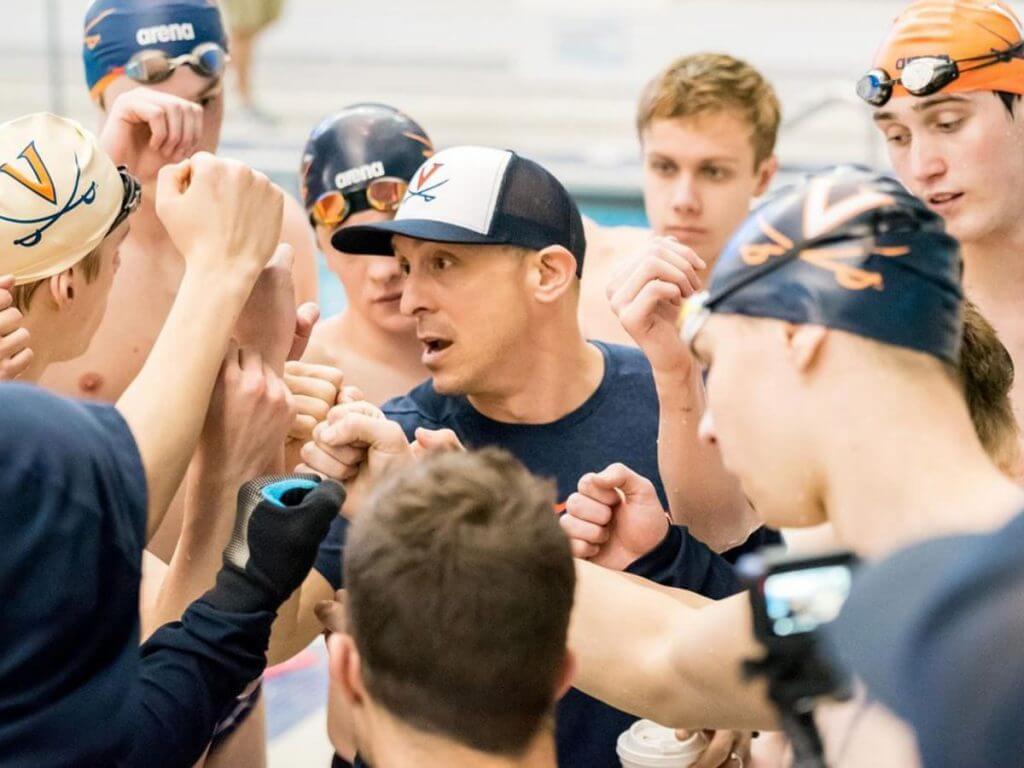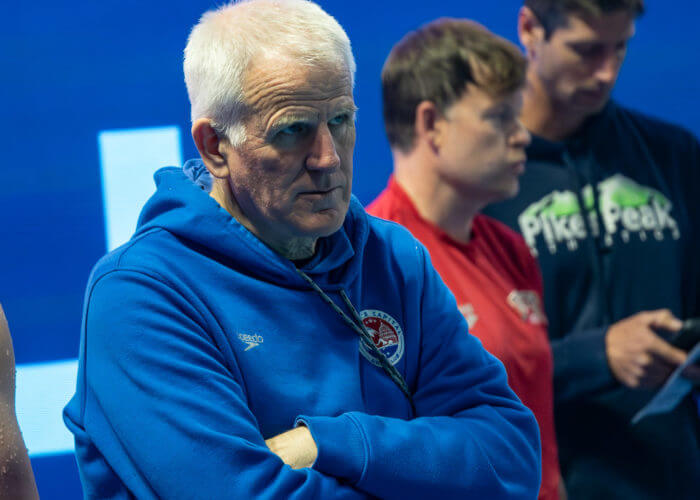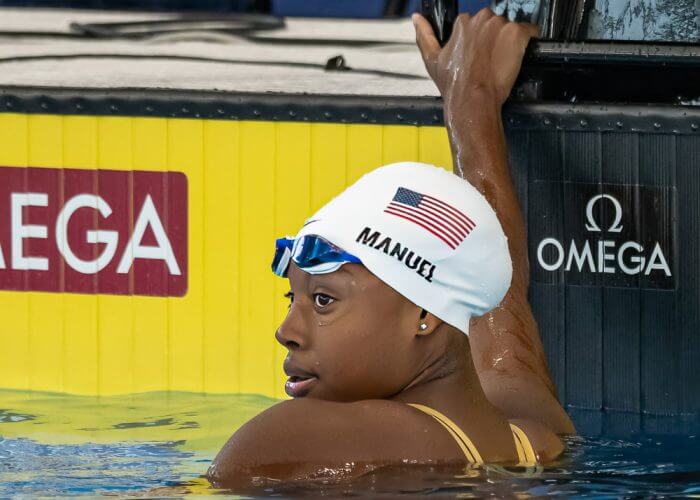How Training Has Changed Since the Onset of the Covid-19 Pandemic

How Training Has Changed Since the Onset of the Covid-19 Pandemic
Four years removed from the worldwide shutdown due to COVID-19, aquatics has re-established a rhythm of training and championships. Paris beckons the world for a second Olympics since, and coaches have resumed mentoring their charges to faster times and a better existence. For many, that has meant a reassessment of the “old way” of training and looking at life.
In March 2020, thanks to a global pandemic, much of the world went on pause. In the U.S., among many other national measures, the NCAA responded by canceling all its championship swim meets. In short, COVID came, saw and conquered, leaving swimmers and coaches wondering, “What comes next?”
The answer for many was an altered way of doing business and living life. Those in aquatics faced seismic changes as closed facilities, limited exposure and reduced hours forced coaches to re-evaluate how to train their charges in a new world environment. What followed was soul searching and epiphanies in order to successfully continue training a ready, willing and able swimming population.
COVID led to introspection regarding training cycles, efficiency, dryland, kicking, recovery, mental health, communication, coach patience and education, among other key ingredients. Says University of Virginia head coach Todd DeSorbo, “During COVID, we learned a lot regarding how much training means.” He’s not alone.
IN PALO ALTO
Time and maturation on the job has wrought change in both art and man. Tony Batis, head coach at Palo Alto Stanford Aquatics, has coached for more than 30 years. “When looking at training over my career, the key influencer to my training changes has been time—how much we have, how we view it, how we spend it and how much is required to get the desired result.
“For me, it has been an evolution from what I knew as an athlete, which carried over to my early years of coaching, followed by a better understanding of swimming science, and then creating training systems to address the needs of the athletes,” says Batis. “Finally, the global pandemic created a reset in my thoughts and emerged as a more streamlined view of getting the job done. This was impacted primarily by facility availability, mindset of the post-COVID athlete and their families, along with a desire for more resets for all.
“In the late ’80s and early ’90s, my general thought was to put forth two-to-three training cycles per year with periods of high volume training, race planning/speed development and rest. My first shift came in the late ’90s and early 2000s when the notion of longer periods of race pace training, coupled with higher volumes of kicking and a more nuanced dryland program, became a larger part of my approach. Our weekly volume dropped about 10-15% on average, but the intensity of workouts along with skill-based drills and movements went up.
“Post-pandemic, I have lost about 15% pre-pandemic water time,” he notes. “As a result, I have created an approach and work balance that allows enough time for work and perpetuation of a culture and environment that families want to be a part of. These days, we get our work done in less time, but still find hours for individual and group meetings as well as gatherings featuring guest speakers from within and without the aquatic world.”
IN FLORIDA
As a beginning coach like Batis, Liz Kershaw, head coach of Hurricane Aquatics in Coral Gables, used a structured training cycle. “Monday morning was aerobic, Tuesday afternoon was quality, etc. I moved away from that some in the mid-2000s and looked at it more from a two-to-three-week cycle standpoint. I wanted to get in X many kick days, Y many quality days, and moved things around based on meets and holidays within that three-week training cycle.
“During COVID, I was forced back to a structured set week for 12-to-14 months. We were fortunate to have the ability to swim in the ocean, so even though our pool time was limited, we were able to expand our open water time. We did three open water days per week, which tended to be aerobic swimming and lots of kicking. Our two-to-three pool workouts were always high quality. We only had 60 minutes of pool time, so I was forced to be very efficient and specific with workouts, and they had a different look than ever before. We did some dryland prep before getting in; then it was go time,” says Kershaw.
“Since COVID, our team has done a hybrid of the two training mindsets. We have kept Tuesday and Saturday as quality days. I have retained fluidity with kick sets, keeping stress days much more dialed in. We kick two-to-three days with longer kick sets during non-meet weeks and early season. Later in the season and on meet weeks, we sprinkle in smaller kick sets daily, and only go one big 1500+ yards kick set.
“I do much more dryland now than when I first started coaching, and it has a lot more structure and specificity. In the early years of coaching club, it was more abs and general preventative shoulder stability, stretch cords and other things. Even when I was coaching college, 1999-2003, if we were not in the weight room, dryland was more generalized,” she says. “Since 2020, our club has been very specific with exercise progression and how dryland fits into a training cycle or body movement in the water.
“These days, we go for generalized stability and flexibility early in the season, and then we move to explosive power-type movements later on. I really like seeing the increased flexibility, strength and power as a result of more focused dryland. While the transition may not be directly related to training during 2020-21, that period when we were forced to spend more time out of the water and swam fast made me re-evaluate what we should do when pool time became available again. Our success due to more focused dryland keeps the coaching staff believing the crossover is beneficial,” says Kershaw.
AN OLYMPIAN PERSPECTIVE

Photo Courtesy: Peter H. Bick
Bruce Gemmell, 2016 assistant Olympic coach, is the father of two credentialed international medalists (Andrew and Erin Gemmell) and former coach of Katie Ledecky. These days, he coaches 15- and 17-year-olds at Nation’s Capital Swimming. “COVID forced us to be more efficient,” he asserts. “The question is should we continue that efficiency, or is that a detriment to the long-term development of the swimmer? I don’t know the answer, but I think we are going to find out. Some coaches have been very successful with shorter work sessions. I’m an Old School guy.”
Will he go back to the old way? “Sort of…and it depends,” he says. “There are some athletes in some events where we can continue with that: 400 IMers, long course-2 flyers and milers. I think we better go back to Old School stuff.
“I’m not training 15-and-17s as I used to. When I was young, I had one tool, and I was going to make everyone a 400 IMer. As you get older, you get more tools. I train all swimmers better now. I’m wiser now, more patient and putting more importance on kicking, dryland and speed,” he says.
HEAD SPACE
During COVID, Jack Roach, former national junior team director for USA Swimming, was director of coach-and-athlete development for TIDE Swimming in Virginia Beach, Va. There, the TIDE coaches rediscovered the importance of engaging their athletes emotionally and psychologically…as have others.
At SwimRVA in Richmond, Va., Coach Jonathan Kaplan notes that since COVID, connectivity with athletes is more paramount. “I’ve always been a proponent of focusing on building the person over the athlete,” he says. “Events of the last few years have reinforced my belief that all coaches and athletes need to focus more on mental health and emotional balance than ever before.
“We have always emphasized process over performance, and that is paying off big-time now. We continue to get faster, but it is happening because we are taking a lot of pressure off the athletes—something that is more critical now than ever. As a result, athlete resiliency is better than ever,” he says.
MORE AWARENESS

simone-manuel-
Michael Phelps, Simone Biles, Simone Manuel, Allison Schmitt and Missy Franklin, among others, have not only brought mental health into the national conversation, but have reoriented coach thinking and subsequent training. “Coming back from COVID, I’ve had to be a little more patient,” says Emory head coach Jon Howell. “We’ve really focused a lot on mental health and psyche. At Emory, we’ve created an endowment to raise awareness of mental health. That’s been a priority,” he says.
Practices, both in-water and dryland, have received a second look as well. Jeff Dugdale at Queens recalls that after COVID, training went “to another level because athletes realized they weren’t promised tomorrow and that a season could be canceled with a moment’s notice.” He also became more flexible, adaptable and introduced more recovery into the team’s training regimen. “These days, I do not hesitate to give someone off if I feel they need it.”
THE UNKNOWN
“The isolation of the pandemic created more extremes in swimmer psyche and demanded a different training approach,” says Batis. “There are some who thrive in isolation and come out of challenges stronger than before. For them, it created higher highs, lower lows and a greater need for understanding stress and anxiety management. This, coupled with facilities shutting down, higher costs in general, less pool time and a smaller pool of candidates for coaching positions, has influenced how we approach training,” he says.
“More than ever, we now need more awareness of everyone’s mind space—including our own—as much as the training plan for the day. Factoring in mental health is always a good thing and can lead to better coaching and stronger performance—but was not always a consideration and needed an adaptive period. The challenges of longer school days and earlier starts to the academic year impacted when and how we compete and when families and swimmers could find their own personal time.
“The influence of social media and watching athletes of all ages perform at higher levels more often (i.e., “Did you hear what so-and-so went last weekend?”) has become more of a norm in swimming. And while you want to stick to ‘your plan,’ it is definitely an influence on how we view performance. This is especially true when considering visibility with college programs and the interest shown based on how fast one swims (during their) freshman, sophomore years or at earlier meets,” says Batis.
“That said, the highest performing athletes always find a way. One thing remains true, the ‘Swimming Bus’ is always moving forward with swimmers getting faster and faster. You may have to make changes so as not to miss the bus, but in the big picture, just being aware of the bus and how it runs will make you better, irrespective of its speed,” he says.
Michael J. Stott is an ASCA Level 5 coach, golf and swimming writer. His critically acclaimed coming-of-age golf novel, “Too Much Loft,” is in its third printing, and is available from store.Bookbaby.com, Amazon, B&N and book distributors worldwide.




Great article, thanks.
I don’t think all that much has changed for club coaches. Club coaches have always dealt with athletes moving through various stages of human growth and development, which have always included disease, injury and “feelings.” Likewise, club coaches have experienced varying changes of physiological and psychological elements during life stages. Finally, there have always been the blending of aerobic development and MaxVO2 development and anaerobic development in short course, long course and in months or years leading up to major meet situations. For coaches who work with athletes year around and over multiple years, experience challenges in every aspect of development; therefore those coaches need a full and complete approach to athlete development. Historically there has been AAU , USAS, EastGermany and steroids, goggles, tech suits, Professional swimming, attraction of better athletes into the sport, and education of coaches over time which has created debate over “the right way” = and Covid which confused all people on so many aspects of “life its own self.” The truth of the matter is that a coach needs to have a good plan, he/she needs to be able to adapt to circumstances, the coach has the luck – or not – of having “talented athletes “ with whom you work. Either way, work diligently until the work is done. Best Wishes to all coaches.